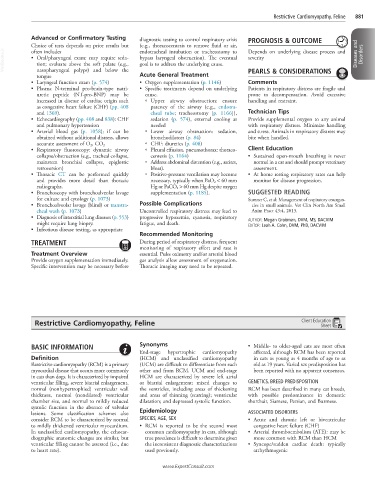Page 1754 - Cote clinical veterinary advisor dogs and cats 4th
P. 1754
Restrictive Cardiomyopathy, Feline 881
Advanced or Confirmatory Testing diagnostic testing to control respiratory crisis PROGNOSIS & OUTCOME
Choice of tests depends on prior results but (e.g., thoracocentesis to remove fluid or air, Depends on underlying disease process and
VetBooks.ir • Oral/pharyngeal exam: may require seda- bypass laryngeal obstruction). The eventual severity Diseases and Disorders
endotracheal intubation or tracheostomy to
often includes
goal is to address the underlying cause.
tion; evaluate above the soft palate (e.g.,
nasopharyngeal polyps) and below the
tongue Acute General Treatment PEARLS & CONSIDERATIONS
• Laryngeal function exam (p. 574) • Oxygen supplementation (p. 1146) Comments
• Plasma N-terminal pro-brain-type natri- • Specific treatments depend on underlying Patients in respiratory distress are fragile and
uretic peptide (NT-pro-BNP) may be cause. prone to decompensation. Avoid excessive
increased in disease of cardiac origin such ○ Upper airway obstruction: ensure handling and restraint.
as congestive heart failure (CHF) (pp. 408 patency of the airway (e.g., endotra-
and 1369). cheal tube; tracheostomy [p. 1166]), Technician Tips
• Echocardiography (pp. 408 and 838): CHF sedation (p. 574), external cooling as Provide supplemental oxygen to any animal
and pulmonary hypertension needed with respiratory distress. Minimize handling
• Arterial blood gas (p. 1058); if can be ○ Lower airway obstruction: sedation, and stress. Animals in respiratory distress may
obtained without additional distress, allows bronchodilators (p. 84) bite when handled.
○ CHF: diuretics (p. 408)
accurate assessment of O 2, CO 2
• Respiratory fluoroscopy: dynamic airway ○ Pleural effusion, pneumothorax: thoraco- Client Education
collapse/obstruction (e.g., tracheal collapse, centesis (p. 1164) • Sustained open-mouth breathing is never
mainstem bronchial collapse, epiglottic ○ Address abdominal distention (e.g., ascites, normal in a cat and should prompt veterinary
retroversion) bloat). assessment.
• Thoracic CT can be performed quickly ○ Positive-pressure ventilation may become • At home resting respiratory rates can help
and provides more detail than thoracic necessary, typically when PaO 2 < 60 mm monitor for disease progression.
radiographs. Hg or PaCO 2 > 60 mm Hg despite oxygen
• Bronchoscopy with bronchoalveolar lavage supplementation (p. 1185). SUGGESTED READING
for culture and cytology (p. 1073) Sumner C, et al: Management of respiratory emergen-
• Bronchoalveolar lavage (blind) or transtra- Possible Complications cies in small animals. Vet Clin North Am Small
cheal wash (p. 1073) Uncontrolled respiratory distress may lead to Anim Pract 43:4, 2013.
• Diagnosis of interstitial lung diseases (p. 553) progressive hypoxemia, cyanosis, respiratory AUTHOR: Megan Grobman, DVM, MS, DACVIM
might require lung biopsy. fatigue, and death. EDITOR: Leah A. Cohn, DVM, PhD, DACVIM
• Infectious disease testing, as appropriate
Recommended Monitoring
TREATMENT During period of respiratory distress, frequent
monitoring of respiratory effort and rate is
Treatment Overview essential. Pulse oximetry and/or arterial blood
Provide oxygen supplementation immediately. gas analysis allow assessment of oxygenation.
Specific intervention may be necessary before Thoracic imaging may need to be repeated.
Restrictive Cardiomyopathy, Feline Client Education
Sheet
BASIC INFORMATION Synonyms • Middle- to older-aged cats are most often
End-stage hypertrophic cardiomyopathy affected, although RCM has been reported
Definition (HCM) and unclassified cardiomyopathy in cats as young as 4 months of age to as
Restrictive cardiomyopathy (RCM) is a primary (UCM) are difficult to differentiate from each old as 19 years. Varied sex predisposition has
myocardial disease that occurs more commonly other and from RCM. UCM and end-stage been reported with no apparent consensus.
in cats than dogs. It is characterized by impaired HCM are characterized by severe left atrial
ventricular filling, severe biatrial enlargement, or biatrial enlargement; mixed changes to GENETICS, BREED PREDISPOSITION
normal (nonhypertrophied) ventricular wall the ventricles, including areas of thickening RCM has been described in many cat breeds,
thickness, normal (nondilated) ventricular and areas of thinning (scarring); ventricular with possible predominance in domestic
chamber size, and normal to mildly reduced dilatation; and depressed systolic function. shorthair, Siamese, Persian, and Burmese.
systolic function in the absence of valvular Epidemiology
lesions. Some classification schemes also ASSOCIATED DISORDERS
consider RCM to be characterized by normal SPECIES, AGE, SEX • Acute and chronic left or biventricular
to mildly thickened ventricular myocardium. • RCM is reported to be the second most congestive heart failure (CHF)
In unclassified cardiomyopathy, the echocar- common cardiomyopathy in cats, although • Arterial thromboembolism (ATE): may be
diographic anatomic changes are similar, but true prevalence is difficult to determine given more common with RCM than HCM
ventricular filling cannot be assessed (i.e., due the inconsistent diagnostic characterizations • Syncope/sudden cardiac death: typically
to heart rate). used previously. arrhythmogenic
www.ExpertConsult.com

